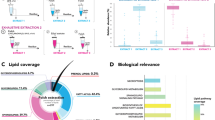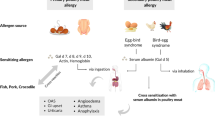Abstract
Clinical definition and appropriate management of anaphylaxis is a clinical challenge because there is large variability in presenting clinical signs and symptoms. Monitoring of the metabolic status of anaphylaxis may be helpful in understanding its pathophysiological processes and diagnosis. The purpose of this study was to conduct GC–MS serum metabolic profiling of anaphylaxis animal models and search for potential biomarkers of anaphylaxis. Thirty-six guinea pigs were randomly divided into an ovalbumin group (n = 12), a cattle albumin group (n = 12), and a control group (n = 12). The IgE level in the serum of the guinea pigs was evaluated by use of ELISA kits and the major metabolic changes in serum were detected by gas chromatography–mass spectrometry. Typical clinical symptoms appeared after the animals had been challenged with ovalbumin or cattle albumin. The IgE levels in serum of both model groups were significantly higher than those of the control group. Clustering trend of the three groups based on variables was observed and nine out of 858 metabolomic features were found to be significantly different between control group and model groups. Among the nine features, six features were tentatively identified as metabolites related to energy metabolism and signal transduction in anaphylaxis. In conclusion, GC–MS-based metabolic profiling analysis might be an effective auxiliary tool for investigation of anaphylaxis.

Chromatographic profile of the derivatized serum

Similar content being viewed by others
References
Decker WW, Campbell RL, Manivannan V, Luke A, St Sauver JL, Weaver A, Bellolio MF, Bergstralh EJ, Stead LG, Li JT (2008) The etiology and incidence of anaphylaxis in Rochester, Minnesota: a report from the Rochester Epidemiology Project. J Allergy Clin Immunol 122:1161–1165
Simons FE, Sampson HA (2008) Anaphylaxis epidemic: fact or fiction? J Allergy Clin Immunol 122:1166–1168
Yocum MW, Butterfield JH, Klein JS, Volcheck GW, Schroeder DR, Silverstein MD (1999) Epidemiology of anaphylaxis in Olmsted County: a population-based study. J Allergy Clin Immunol 104:452–456
Silva IL, Mehr SS, Tey D, Tang ML (2008) Paediatric anaphylaxis: a 5 year retrospective review. Allergy 63:1071–1076
Lieberman P, Camargo CA Jr, Bohlke K, Jick H, Miller RL, Sheikh A, Simons FE (2006) Epidemiology of anaphylaxis: findings of the American College of Allergy, Asthma and Immunology Epidemiology of Anaphylaxis Working Group. Ann Allergy Asthma Immunol 97:596–602
Bjornsson HM, Graffeo CS (2010) Improving diagnostic accuracy of anaphylaxis in the acute care setting. West J Emerg Med 11:456–461
Kemp SF, Lockey RF (2002) Anaphylaxis: a review of causes and mechanisms. J Allergy Clin Immunol 110:341–348
Ono E, Taniguchi M, Mita H, Fukutomi Y, Higashi N, Miyazaki E, Kumamoto T, Akiyama K (2009) Increased production of cysteinyl leukotrienes and prostaglandin D2 during human anaphylaxis. Clin Exp Allergy 39:72–80
Watkins SM, German JB (2002) Metabolomics and biochemical profiling in drug discovery and development. Curr Opin Mol Ther 4:224–228
Dettmer K, Aronov PA, Hammock BD (2007) Mass spectrometry-based metabolomics. Mass Spectrom Rev 26:51–78
Kenny LC, Dunn WB, Ellis DI, Myers J, Baker PN, Consortium G, Kell DB (2005) Novel biomarkers for pre-eclampsia detected using metabolomics and machine learning. Metabolomics 1:227–234
Underwood BR, Broadhurst D, Dunn WB, Ellis DI, Michell AW, Vacher C, Mosedale DE, Kell DB, Barker RA, Grainger DJ, Rubinsztein DC (2006) Huntington disease patients and transgenic mice have similar pro-catabolic serum metabolite profiles. Brain 129:877–886
Michell AW, Mosedale D, Grainger DJ, Barker RA (2008) Metabolomic analysis of urine and serum in Parkinson’s disease. Metabolomics 4:191–201
Thysell E, Surowiec I, Hornberg E, Crnalic S, Widmark A, Johansson AI, Stattin P, Bergh A, Moritz T, Antti H, Wikstrom P (2010) Metabolomic characterization of human prostate cancer bone metastases reveals increased levels of cholesterol. PLoS One 5:e14175
Chen T, Xie G, Wang X, Fan J, Qiu Y, Zheng X, Qi X, Cao Y, Su M, Wang X, Xu LX, Yen Y, Liu P, Jia W (2011) Serum and urine metabolite profiling reveals potential biomarkers of human hepatocellular carcinoma. Mol Cell Proteomics 10(M110):004945
Yang J, MacDougall ML, McDowell MT, Xi L, Wei R, Zavadoski WJ, Molloy MP, Baker JD, Kuhn M, Cabrera O, Treadway JL (2011) Polyomic profiling reveals significant hepatic metabolic alterations in glucagon-receptor (GCGR) knockout mice: implications on anti-glucagon therapies for diabetes. BMC Genomics 12:281
Favretto D, Cosmi E, Ragazzi E, Visentin S, Tucci M, Fais P, Cecchetto G, Zanardo V, Viel G, Ferrara SD (2012) Cord blood metabolomic profiling in intrauterine growth restriction. Anal Bioanal Chem 402:1109–1121
Dunn WB, Ellis DI (2005) metabolomics: current analytical platforms and methodologies. TrAC Trend Anal Chem 4:285–294
Wu Z, Huang Z, Lehmann R, Zhao C, Xu G (2009) The application of chromatography – mass spectrometry: methods to metabonomics. Chromatographia Supplement 69:S23–S32
Canning BJ (2003) Modeling asthma and COPD in animals: a pointless exercise? Curr Opin Pharmacol 3:244–250
Sieber M, Hoffmann D, Adler M, Vaidya VS, Clement M, Bonventre JV, Zidek N, Rached E, Amberg A, Callanan JJ, Dekant W, Mally A (2009) Comparative analysis of novel noninvasive renal biomarkers and metabonomic changes in a rat model of gentamicin nephrotoxicity. Toxicol Sci 109:336–349
Kemp SF, Lockey RF (2011) Pathophysiology and organ damage in anaphylaxis. In: Castells MC (ed) Anaphylaxis and hypersensitivity reactions. Springer Science+Business Media, LLC, New York, pp 33–46
Muszbek L, Csaba B (1973) Changes of blood glucose during anaphylaxis in pertussis sensitized rats. Experientia 29:1411–1412
Reginald H, Garrett CM (2006) Biochemistry, 3rd edn. Cole Publishing, Kentucky
Janardhan A, Chen J, Crawford PA (2011) Altered systemic ketone body metabolism in advanced heart failure. Tex Heart Inst J 38:533–538
Huang YH, Sauer K (2010) Lipid signaling in T-cell development and function. Cold Spring Harb Perspect Biol 2:a002428
Kuehn HS, Beaven MA, Ma HT, Kim MS, Metcalfe DD, Gilfillan AM (2008) Synergistic activation of phospholipases Cgamma and Cbeta: a novel mechanism for PI3K-independent enhancement of FcepsilonRI-induced mast cell mediator release. Cell Signal 20:625–636
Leung WH, Tarasenko T, Bolland S (2009) Differential roles for the inositol phosphatase SHIP in the regulation of macrophages and lymphocytes. Immunol Res 43:243–251
Roongapinun S, Oh SY, Wu F, Panthong A, Zheng T, Zhu Z (2010) Role of SHIP-1 in the adaptive immune responses to aeroallergen in the airway. PLoS One 5:e14174
Acknowledgments
The authors acknowledge financial support by the Special Projects Research and Innovation Conditions in Hunan Province (no: 2010TT2025) and the Major Projects Plan of Science and Technology in Changsha (no: K0904032-11).
Conflict of interest
The authors declare that there are no conflicts of interest
Author information
Authors and Affiliations
Corresponding authors
Additional information
Hu and Wu contributed equally to the article
Rights and permissions
About this article
Cite this article
Hu, X., Wu, Gp., Zhang, Mh. et al. GC–MS-based metabolic profiling reveals metabolic changes in anaphylaxis animal models. Anal Bioanal Chem 404, 887–893 (2012). https://doi.org/10.1007/s00216-012-6129-x
Received:
Revised:
Accepted:
Published:
Issue Date:
DOI: https://doi.org/10.1007/s00216-012-6129-x




